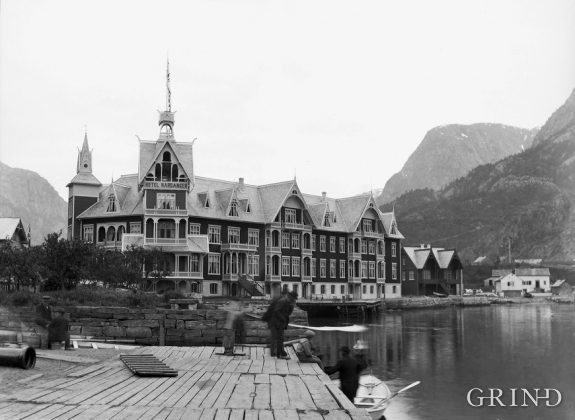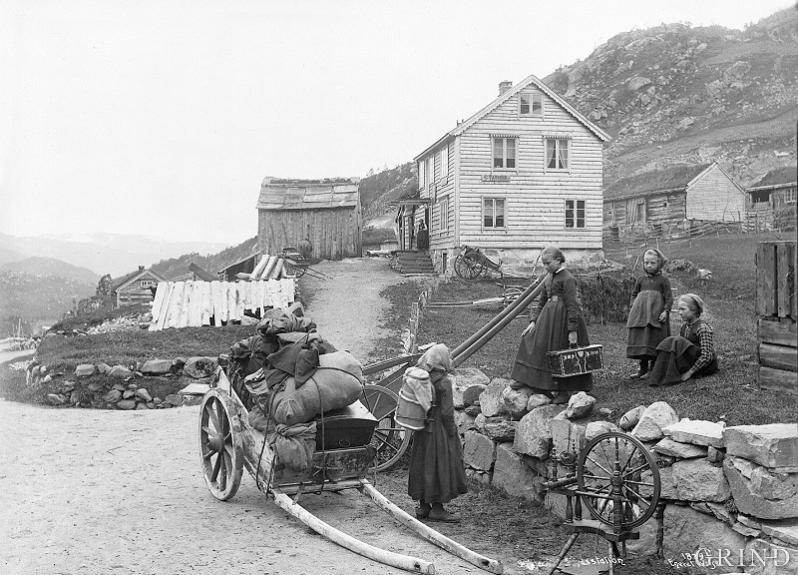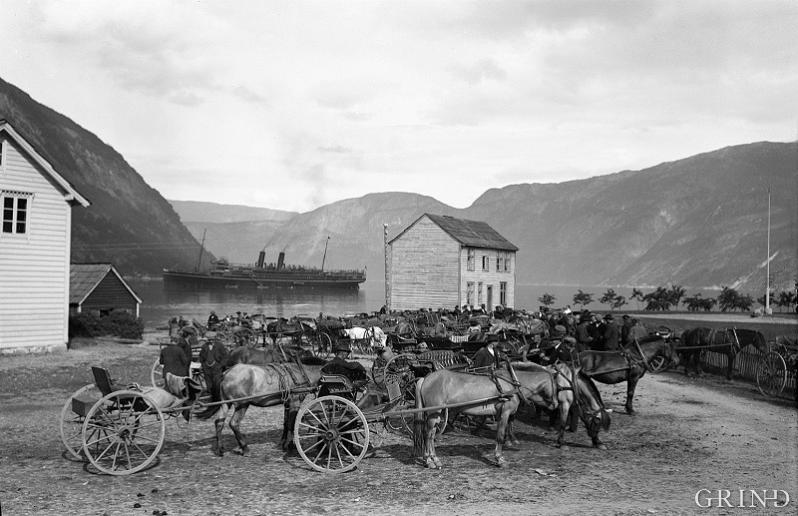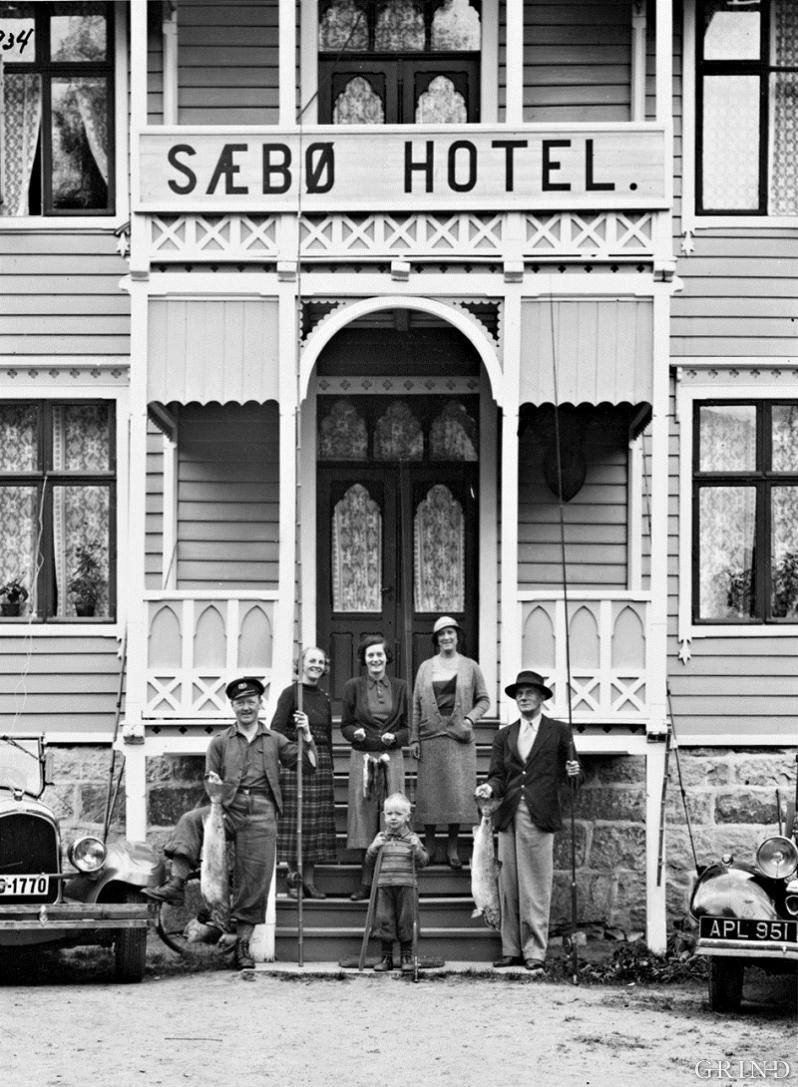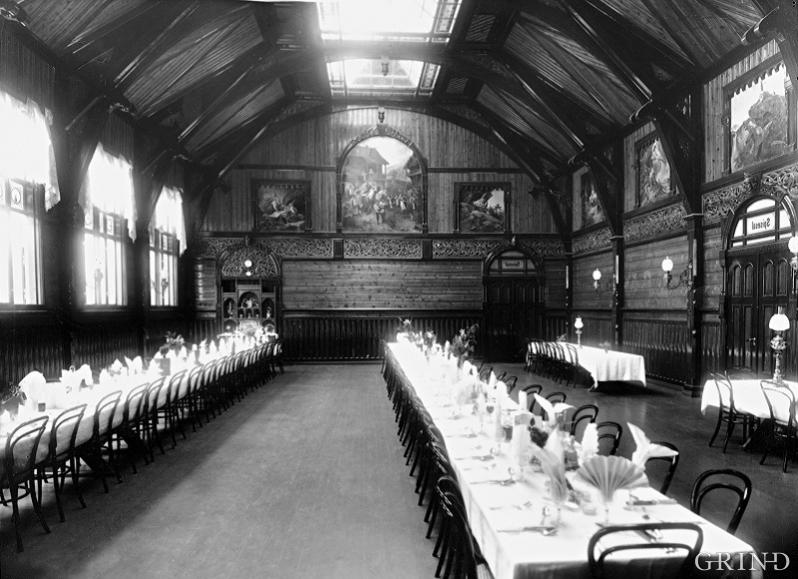Published: 19.05.2009 | Author: Randi Bårtvedt, Axel Mykleby
The second Hotel Hardanger in Odda was built in 1896. Apart from Stalheim and Holmenkollen (in Oslo) this was one of the biggest tourist hotels in the country. (Knud Knudsen, owner: Billedsamlingen, Universitetsbiblioteket i Bergen (KK 550(21x27))).
Tourist travel in western Norway experienced its great breakthrough with the regular scheduled steamship traffic. In 1853 the route between Hamburg and Bergen opened and from 1861 tourists and other travellers could take the steamship further up the fjord to Hardanger. It was then that Ananias Dekke got the newly built steamship “Vøringen” going.
The pioneer tourists in the 1830s and 1840s got tourism going in the mountain country of Norway. In their travel descriptions they wrote about everything from geology and botany to history and culture. They created expectations as to wild and beautiful Nature and a colourful people in harmony with the landscape. But right from the beginning of the 19th century scientists and artists had launched trips of exploration in the mountains and the west of Norway. They opened up the eyes of many for the landscape and the Nature. Paintings like “The Bridal Party in Hardanger” by Adolph Tidemand and Hans Gude awakened people’s admiration and interest.
Romanticism’s view of nature and love of adventure created great interest in travel amongst foreigners, and they often ignored the difficulties with access and with finding a decent place to stay. At the time there were no hotels in the district, only coaching inns with simpler facilities. Many rectories served as lodging houses for distinguished travellers. Rector Nils Hertzberg in Ullensvang noted down all the visits in his guestbook - in practice he was one of the first tourist hosts in Hardanger - and before 1821 he had only been visited by two foreigners. The rectory in Ullensvang had a good reputation in early tourism and gradually the coaching station at Utne got a reputation for good management. Today Utne is one of the oldest hotels in the country still in operation.
The local residents themselves were aware at an early stage of what the tourists were looking for, and they began to further develop the “travel product”. In 1874 the local newspaper, “The Hardanager Newspaper” wrote proudly of what the tourists could experience in the district:
“They come to breathe Hardanger’s healthy air, to view its imposing Nature, the people with their ringing dialect, with their habits and their customs and their national dress ……. ”
Within a few years Odda parish in Søndre Bergenhus County was the hub for the tourist industry in western Norway. Most of the district consists of high mountains and the farms are small and run with a little help during the summer. At the end of the 19th century the only prospect for many was poverty, and emigration to America was extensive. Tourism was a new means of subsistence for rural people; as seasonal work and as a supplementary income.
In 1898 the local newspaper observed large changes in the district:
“If we compare Odda of now with 50 to 60 years ago, the difference will be overwhelming. Hardly any rural district in Hardanger can show such change and progress. Then there were a couple of small houses down on the bay. Nothing much stirred and no one had any idea about what tourists were. Now the whole bay has been reconstructed, and the value of tourism can be counted in the hundreds of thousands (kroner)”.
Tourist travel and tourist hotels
Without doubt Odda and Hardanger provide us with a representative picture of the first great tourist period in western Norway. The increase in tourism needed more hotels. The ship route between Newcastle and Bergen opened in 1890; the new mountain road from Telemark was completed in 1889, and in 1890 one could drive for the first time through Bratlandsdalen from Suldal to Odda. The shoreline resort at the bottom of Sørfjord had become, in earnest, a nodal point for traffic between East and West Norway.
Many of the new hotels which were erected were family affairs with hired help in accordance with size and standard. In Odda six hotels were erected by and by in the centre, and six others were built in the district. Hotel keepers were invariably local folk, with a background in trading and coaching. Many of them had been overseas, as emigrants or in the service of rich folk. The theology professor Dr. Henry Boyd from Oxford came as a sports fisherman to Odda in the 1870s and was an annual guest from then on, right up until the outbreak of war in 1914 put an abrupt end to all tourism for some years. He got himself his own summer villa in Odda, a fishing cabin in Reinsnos and rented salmon fishing rights on the Opo river. He hired Sven Tollefsen Buer, the son of a shore crofter as his guide and gaffer. For a couple of winters Sven worked as a servant in Boyd’s house in England. When the biggest hotel in Odda was up for sale, Sven bought it with financial assistance from the rich Englishman. Now the hotel was called: “Hotel Hardanger” and had 100 beds in 1887. It was a modern one, and run on English lines, with lunch in the middle of the day and dinner at 7 p.m. Sven died young, and his brother MIKAL came home from Philadelphia and took over. He opened a new “Hotel Hardanger ” (1896), after the old one burnt down. The new hotel had 110 rooms with 117 beds and a dining room for 250 guests, and it had electricity made by a coal-fired generator.
The hotel families were the core of the tourism business and belonged to the bourgeoisie of the rural districts. Sofie Tellefsen, and no one else, was entitled “Madame” and the hotel children had their own governess and received piano lessons. There was a future in the hotel business. The farm heir Ola H. Prestegard (1832-1900) gave over his farm, and built a hotel on the boat place at the steamship quay. Prestgård’s Hotel was later extended, and the name was the Grand Hotel (1898), the second largest in Odda. Hotel servants in uniform and with handcarts met up at the quay and shouted: “Please Hotel Hardanger” or “Please Grand Hotel”. The Englishmen dominated the “Hotel Hardanger” and the Germans preferred to stay at the “Grand”.
The tourist John L.Stoddard told in 1897 that Odda was the only place in Norway where he had had difficulty in obtaining a room. When the boat docked at the quay there was a pure scramble to get to the hotel first. In the reception it was as lively as one would expect in the New York Stock Exchange. The hotel keeper got completely mixed up and she shouted out the room numbers like an auctioneer.
Who were the tourists?
In the year 1904 the police officer who was stationed at Odda during the tourist season noted that traffic was especially great with 83 foreign and 5 domestic calls by tourist vessels and yachts. There were 7,719 tourists on board. At least 12,000 tourists came by sea in that year.
Most of the tourists were Englishmen and rich folk, but the flow of tourists gradually lost its aristocratic stamp. At the end of the 19th century the middle classes were in the majority, employees from the coal-fired cities of England and the Continent travelled on overseas holidays. The hotel guest books tell us that most of the travellers were foreigners and men. Some had their families with them, women seldom travelled unaccompanied. Those who stayed in hotels, usually stayed for three days, enough to enjoy the natural attractions. Odda being the main attraction. The return trip to Buar glacier took 6 to 7 hours on foot, to Låte waterfall 5 hours by horse and carriage, to Folgefonna glacier 10 hours on foot, and to Skjeggedals waterfall it took 12 hours, partly by rowing boat and partly on foot.
The tourists rarely came into contact with the rural folk, since the class and language differences were too great. When they were not on excursions the tourists kept to the hotels, and there the local folk did not dare to set foot. From the 1890s onwards the Englishmen had had their own priest at Odda, with divine services for travellers. At Utne English tourists were also predominant, and here divine services have been held in English right up to our own times.
Rural folk in the toursit business
In Odda it was mainly the people in the central areas who made their main living from running hotels, tourist traffic, trading and handicrafts. In 1900 the town on the shore numbered 27 residential houses with 285 people. The other 1,100 persons or so who lived in the parish lived mainly off agriculture.
Both the hotel keepers and the tourist traders did well. There were several tourist ships in the centre. The major traffic in “floating hotels” increased the sale of souvenirs. Ole Th.Ohm (1864-1942) began with a tourist shop in Odda. At one time he had branch shops in Voss, Sogn and at Nøstet in Bergen. He had experience from big shops in the USA and now he sold farming antiquities, rural handicrafts, silverware and post cards which were particularly popular. The photographer Knud Knudsen (1832-1915) came from Tokheim in Odda and photographed natural and cultural landscapes all over the country. The most important of his customers were tourists. Anna Jordal, the shoemaker’s wife, opened a dress shop with traditional dress and Hardanger sewing work. She foresaw income from women’s handicrafts in the district.
All age groups took part in the tourist business and most of them were men. Men provided coach transport, were tourist guides and hotel personnel. Women worked in the kitchen and were responsible for board and lodging in the hotel, for cleaning and tidying up. In the winter season both women and men made tourist goods. In the 1900 census 45 women state that they are involved in the tourist trade; half of them were unmarried and in their twenties. The hotel girls had long days, often from 5 a.m. to 11 p.m. They had better wages than girls doing farm work, and they got tips as well.
The coachmen were busy when the passengers from the tourist ships were going to Låte waterfall. “Kidnapping of customers” did occur and there was competition in getting more trips. The police officer wrote in 1904 that the profit from coach trips was “mean” for most of them. Only those who had contacts with the hotels and several carriages had a higher income.
The fantasy hotels
For rural people the tourist hotels of the 1880s and the 1890s must have looked like veritable palaces, in comparison with a usual farmer’s home. The size, the architecture, the lavish décor, the electric light and the siting within the landscape gave many of these hotels a touch of a “fairy-tale palace”. But there were major differences between them, in price, size and décor.
The third Stalheim Hotel was 15 to 20 times as expensive as one of the small hotels, but so too was the total floor area of 3,000 square metres, as opposed to 200 to 300 square metres for most of them. Besides Holmenkollen Hotel (in Oslo), the Stalheim Hotel must have been the most magnificent in Norway. Like so many of these wooden hotels built in the Swiss style it had a brief life span and burnt down after a year of operations. Of the 60 or so hotels from the 1880s and the 1890s in Hordaland County half of them have disappeared through fire, demolition or moving. Today scarcely 10 of them are still in use as hotels.
Most of these fantasy and the biggest hotels in Norway were situated in Hordaland County. Amongst these was first and foremost Hotel Hardanger in Odda which remained there right up until 1977 – the second, third and fourth Stalheim Hotel – which burnt down in 1959 – and Fleischers Hotel in Voss, one of the few Swiss style hotels in Norway still in full operation, which distinguished themselves. Many hotels from that period were from the start small, and grew through extensions, as farmhouses did on farms. To a large extent we know who the owners were but we do not always know the name of the builder. Among those we do know in Hordaland, there are three in particular who stand out. These are Knut Th. Kvale from Voss, Lars Fixen and Anders O. Steine, the latter two being from Kvam. Steine was also educated as an architect from Hannover, and it was he who designed and built Sandven Hotel in Norheimsund.
With the hotels not only a new style of building was introduced to the rural districts - the Swiss style – with an element of “Nordic” dragon style - but also for the first time architects were used to design buildings other than churches. We can assume that designing hotels was an interesting assignment, as several of the best known architects of the time designed them. Amongst these we find Ole Bull’s nephew Schak A.S.Bull who designed Stalheim Hotel II and III, the architect, engineer and archaeologist Peter Blix who is known for a series of restoration works on medieval churches and who designed Fleischers Hotel and Mundal Hotel in Fjærland; in addition one of Bergen’s most frequently utilised architects Johan D.I.Faye and Hans Heinrich Jess who was born in Germany who designed Hotel Hardanger II, Breifond Hotel in Røldal, Mæland Hotel in Granvin, Hotel Maristuen in Lærdal and Hotel Norge in Bergen.
Even although the style and the form of these hotels were new - towers and oriels, balconies and verandas, equipped with lacework of carved mouldings and profiles – the building techniques themselves were traditional. Hotels were partly built with cogged joints, partly half-timbered, and the material was pine and fir. A new trait was also the high foundations or the cellar floor, and the foundation in these buildings. Besides the large dining rooms and the entrance halls often required little more daring construction and thus special knowledge on the part of the builder.
In addition to the dimensions, these buildings distinguished themselves - as do all Swiss style buildings from the period - precisely in respect of the decoration. On the outside the rich fretsaw work adorned the verandas and balconies, windows and gables. The verandas and balconies with the sharply projecting roofs were, however, not there only for decoration. They were also important in following up the theories as regards the health influence of fresh air, while at the same time one could sit protected from direct sunlight. Besides - and this was perhaps the most important things for tourist hotels - it was here that the hotel guests could admire the magnificent view out over the landscape.
The national romantic style and the dragon style
Inside the bigger hotels, the sitting rooms and dining rooms were often beautifully decorated with big portraits of popular life and paintings of landscapes - a result of the National Romantic landscape art and an emphasis on special national features and values. We can still see this in Sandven Hotel in Norheimsund and Vøringsfoss Hotel in Eidfjord. The one that was most richly decorated, the Hotel Hardanger II in Odda
has gone today.
In Hotel Hardanger Lars Kinsarvik, the wood carver blossomed with his characteristic “dragon style”. He was the leader of the wood carving milieu in Hardanger, and “national” wood carving was used to decorate both the fixed interior decorations on the walls, and the furnishings in the tourist hotel.
In this way these hotels were innovators and driving forces and markets for local creative forces in the rural districts. Despite the fact that the Swiss style was an international style with its origins in the German Romantic movement early in the 19th century, the style took upon a special national and local design in Norway.
The local traditions were adapted to tourism. Serving girls in traditional dress with a red bodice were the icing on the cake in the wood carved interior of the hotels. The traditional dress was both the attraction and a souvenir; figures were dressed in traditional dress and decorations and exhibited. Many did not like these reproductions of themselves in the shops, and here we have the dilemma of the tourist industry, also today; the Norwegian cultural traditions cannot only be a sales item. The fantasy hotels introduced in many ways the Golden Age of tourism. Today many of these hotels have gone; and the same has happened to many of the natural attractions which brought travellers to this country. Now these hotels themselves have become part of the historical cultural heritage, if somewhat differently than 100 years ago, when Norway served to an even greater degrees as a “reservation” in Europe.
- Bårtvedt, R. (1984) "Vor gode bræ også i sommer beskuet af høifornemme øine": møtet mellom turistar og bygdefolk i Odda 1861-1914. Hovudoppgåve i etnologi, Universitetet i Bergen.
- Mykleby, A. C. (1982) De fantastiske hotellene. I: Foreningen til norske fortidsminnesmerkers bevaring, Årbok. Oslo, Foreningen, s. 141-162.
- Opedal, H. O. (1980) Turistferdsla i Hardanger før bilen kom. Bergen.

